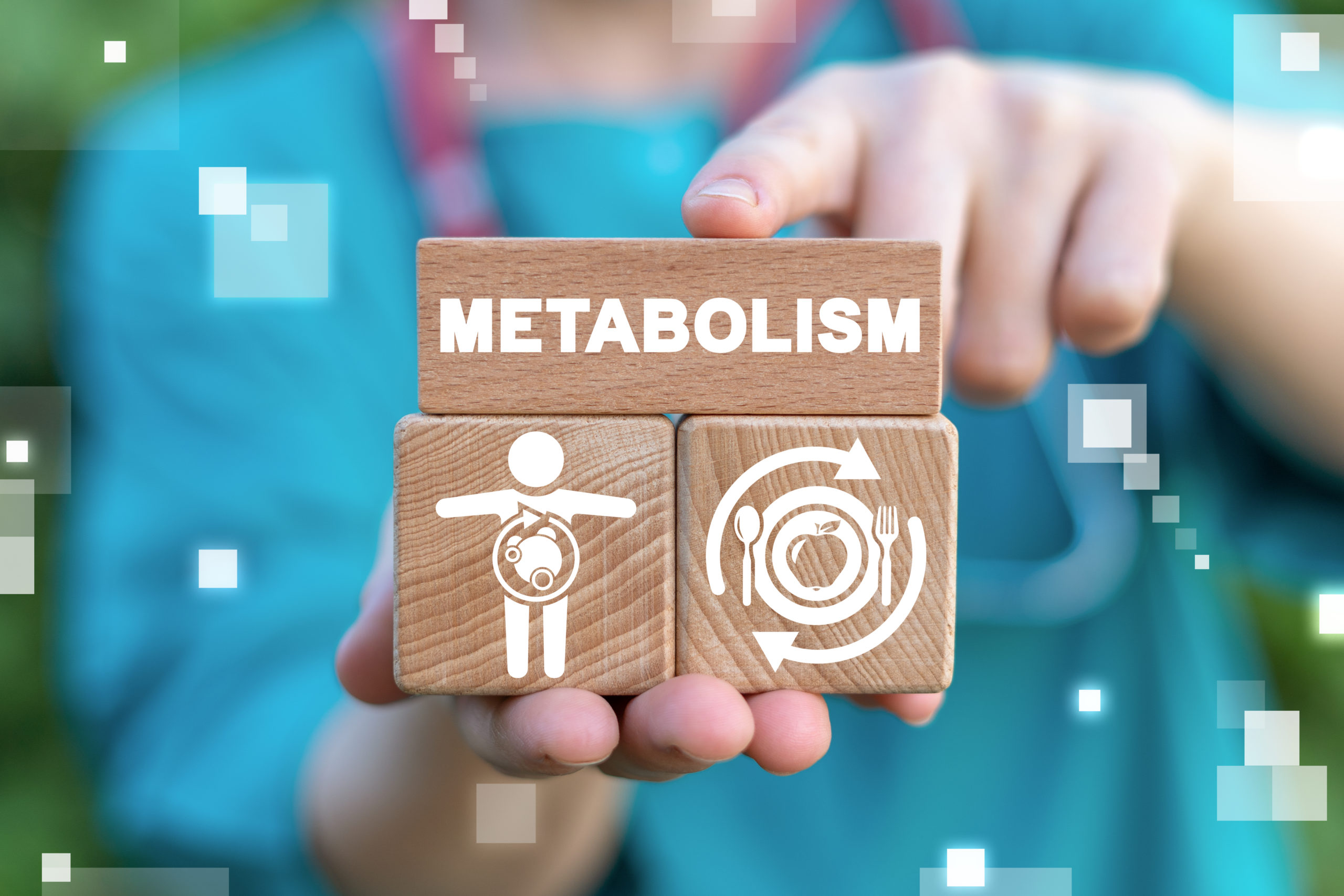What are metabolism and weight changes?
All humans take in energy (in the form of food) and then burn that energy as the fuel to keep all life functions, like breathing and brain activity, happening. Metabolism can be defined as the conversion of food into chemical energy that is used to power the body’s activities and to build all parts of the body’s structure, including bones, muscle and fat.
Changes in weight, whether increasing or decreasing, can be simplistically viewed as energy imbalances happening between energy in and energy out. This energy in and out is called total energy expenditure.
The term ‘total energy expenditure’ is made up of three interacting components:
- the base rate at which your body burns calories to stay alive and functioning properly (your metabolic rate);
- the energy used to break down food (dietary thermogenesis); and
- physical activity (which determines how much energy is used during physical activities of daily living like moving around, breathing and exercising).

Weight Gain or Loss in the Transition to Menopause
In sedentary adults (those who are generally inactive), base or resting metabolic rates account for about 60% to 70% of total energy output, the dietary thermogenesis for around 10%, and physical activity for the remaining 20% to 30%. These proportions change if physical activity is increased, depending on the amount and intensity of the activity. As more energy is used due to increased physical activity, the rate at which your base metabolism burns energy increases. So, with movement and physical activity, not only does the amount of energy burned increase directly as a result of the activity, but it also increases the rate at which your body burns energy while resting.
Energy from food is stored in the form of adipose tissue (fat) beneath the skin (called subcutaneous fat) and around the organs (called visceral fat or central adiposity). This is normal and healthy, and because central adiposity is not the same as subcutaneous belly fat, even those who may be considered normal or underweight may still be impacted by central adiposity. Central adiposity can increase as a result of a sedentary lifestyle, a decrease in healthy recreational movement and exercise, decreased quality of sleep, shift work, and a poor diet.
However, changes to the proportions of central adipose tissue versus subcutaneous adipose tissue can lead to obesity and to other serious health concerns such as metabolic syndrome. This syndrome is a cluster of conditions such as high blood pressure and abnormal cholesterol levels that increase the risk of heart disease, stroke and type 2 diabetes. [1] [2] [8]
Consult with a health care provider if experiencing sudden and unexplained weight loss, as this may indicate an underlying medical condition.
Menopause Belly
Women in the menopausal transition typically gain weight and experience changes in the composition of their body fat [3]. The increase in body mass index (BMI – one commonly used measure of adiposity), is seen in multiple studies regardless of menopausal status, so menopausal changes are not the only cause. However, the increased storage of central adipose tissue is clearly linked to menopausal stage. [3]
Subcutaneous body fat is positively associated with vasomotor symptoms (primarily hot flashes), so the more body fat you have, the more likely you are to have vasomotor symptoms. This is consistent with the model of body fat acting as an insulator. The relationship between fat gain and hot flashes is most pronounced among Caucasian and Chinese women, compared to African-American or Japanese women. However, no consistent associations between subcutaneous fat gain and night sweats was observed in the study.[7]
Self-care & Natural Remedies for Metabolic and Weight Changes
We all need and deserve movement and physical recreation for good health, and the menopausal transition is an excellent time to prioritize what you need for optimal health.
Recall that we defined metabolism as the conversion of food into chemical energy, which is then used to power the body’s activities and to build the body’s structures. We will refer to the use of energy as energy expenditure, and resting energy expenditure is the same as basal metabolic rate (or resting metabolic rate). Any physical activity directly increases energy expenditure, and it also causes an increase in resting energy expenditure. Given this, some of the most effective and meaningful self care activities surrounding weight gain and metabolism will involve body movement and activity. [8]
In the US, the recommended minimal level of physical activity for health benefits is 500 MET-min/week. One MET, or metabolic equivalent, is defined as the amount of oxygen consumed while at rest and it is used as a proxy for resting metabolic rate. Multiplying the MET can express how much energy is used during physical activity. So, moderate intensity activity, such as walking at 5 km/hr, uses about 3.3 MET. Vigorous activity, such as jogging at 8 km/hr, uses about 6 MET. Meeting the suggested 500 MET-min/week is achievable by walking for about 150 min (2.5 hours) per week or just over 20 mins per day. [8] This may or may not be easy for you to achieve immediately, but starting any movement is a step in the right direction!

Managing Weight and Metabolism Changes
In addition to movement, the following can also help you manage your weight and metabolism:
- Eat a balanced and healthy diet with a variety of fruits and vegetables. If you can, seek help from a qualified nutritionist.
- Good sleep hygiene (getting enough rest in a positive sleep environment) is essential because key hunger-regulating hormones (leptin and ghrelin) regulate food intake and they are released at night.
- Avoid stress eating and night eating if possible.
- Dehydration can make you feel hungry when all you need is water.
- Journal “trigger events” so you can have more awareness of when you eat in an unhealthy way, and then try to find ways to avoid the triggers or make adjustments to your lifestyle (e.g. stop eating while watching tv).
- Start a mindfulness practice, such as meditation. This releases stress and also helps to increase body positivity and acceptance of your individual life.
- Seek food security. Your healthcare provider or nutritionist can help take control of an economical and enjoyable home-made food menus.
Therapy & Treatment for Metabolic and Weight Changes
At age 40 find a reliable, educated primary care provider familiar with recognizing and treating symptoms of perimenopause and menopause. The North American Menopause Society provides a list of menopause practitioners here.
Get a physical check-up with a healthcare provider before you start an exercise program and to get recommendations for the best program based on your physical health (e.g. taking into account any joint problems you have). Psychological counselling or therapy can help with eating disorders and re-train eating habits.

Estrogen Hormone Therapy in Perimenopause
Estrogen hormone therapy in younger post-menopausal women (aged 50-59 years), reduces fat mass, improves bone-mineral density, and preserves lean body mass, reducing the risk of type-2 diabetes specifically and overall mortality risk generally. However, because of the relationship between fat mass and lean body mass, net weight may not change. Hormone therapy, or hrt and weight gain is not scientifically supported. [8]
Elevated Follicle Stimulating Hormones in Perimenopause
Elevated follicle stimulating hormones (FSH) levels are natural during the menopausal transition, but they act to reduce bone mass and increase central adiposity. New therapeutic drugs are aimed at reducing the secretion of FSH or blocking FSH action using a specific antibody. These may be more effective and better tolerated by women who can’t or prefer not to use hormone therapy with estrogen [9]
The Science
Role of hormones
MYSTERY
Obesity research is starting to find some of these answers, but frustratingly at the moment it remains a mystery.
MYTH
Healthy weights can be achieved and maintained. While hormones affect metabolism and fat deposition, achieving a healthy weight and comfort with your changing body is always possible.
MYTH
Absolutely not – as the science shows, fat is complex and influenced by multiple factors including female hormones, and metabolism. Will power can help you make positive choices, but losing weight occurs over the long term, so behavioural changes around food and movement are very important to stoke your metabolism.
MYTH
Hormone therapy with estrogen, combined with regular movement, good nutrition, and good sleep can help women decrease their weight.
References
[1] Ji, Y., Liu, P., Yuen, T., Haider, S., He, J., Romero, R., Chen, H., Bloch, M., Kim, S. M., Lizneva, D., Munshi, L., Zhou, C., Lu, P., Iqbal, J., Cheng, Z., New, M. I., Hsueh, A. J., Bian, Z., Rosen, C. J., Sun, L., … Zaidi, M. (2018). Epitope-specific monoclonal antibodies to FSHβ increase bone mass. Proceedings of the National Academy of Sciences of the United States of America, 115(9), 2192–2197. https://doi.org/10.1073/pnas.1718144115
[2] Metabolic Syndrome https://www.mayoclinic.org/diseases-conditions/metabolic-syndrome/symptoms-causes/syc-20351916
[3] Zaidi, M., Lizneva, D., Kim, S. M., Sun, L., Iqbal, J., New, M. I., Rosen, C. J., & Yuen, T. (2018). FSH, Bone Mass, Body Fat, and Biological Aging. Endocrinology, 159(10), 3503–3514. https://doi.org/10.1210/en.2018-00601
[4] Sowers, M., Zheng, H., Tomey, K., Karvonen-Gutierrez, C., Jannausch, M., Li, X., Yosef, M., & Symons, J. (2007). Changes in body composition in women over six years at midlife: ovarian and chronological aging. The Journal of clinical endocrinology and metabolism, 92(3), 895–901. https://doi.org/10.1210/jc.2006-1393
[5] Senapati S, Gracia CR, Freeman EW, Sammel MD, Lin H, Kim C, Schwab RJ, Pien GW. Hormone variations associated with quantitative fat measures in the menopausal transition. Climacteric. 2014;17(2):183–190.
[6] Vieira-Potter, V. J., Zidon, T. M., & Padilla, J. (2015). Exercise and Estrogen Make Fat Cells “Fit”. Exercise and sport sciences reviews, 43(3), 172–178. https://doi.org/10.1249/JES.0000000000000046
[7] Thurston, R. C., Sowers, M. R., Sternfeld, B., Gold, E. B., Bromberger, J., Chang, Y., Joffe, H., Crandall, C. J., Waetjen, L. E., & Matthews, K. A. (2009). Gains in body fat and vasomotor symptom reporting over the menopausal transition: the study of women’s health across the nation. American journal of epidemiology, 170(6), 766–774. https://doi.org/10.1093/aje/kwp203
[8] Leeners, B. et al. (2017) Ovarian hormones and obesity.Hum Reprod Update. 2017 May; 23(3): 300–321. doi: 10.1093/humupd/dmw045
[9] Liu, P., Ji, Y., Yuen, T., Rendina-Ruedy, E., DeMambro, V. E., Dhawan, S., Abu-Amer, W., Izadmehr, S., Zhou, B., Shin, A. C., Latif, R., Thangeswaran, P., Gupta, A., Li, J., Shnayder, V., Robinson, S. T., Yu, Y. E., Zhang, X., Yang, F., Lu, P., … Zaidi, M. (2017). Blocking FSH induces thermogenic adipose tissue and reduces body fat. Nature, 546(7656), 107–112. https://doi.org/10.1038/nature22342
Not AI generated.
Original content, last updated February 22, 2023.
© 2024 Herstasis® Health Foundation






